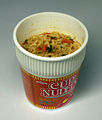Convenience food
Convenience food [ ˌkən.ˈviːnjəns fuːd ] ( ) or convenience food is a term borrowed from English for “convenient eating” ( convenience for “convenience”, food for “eating”). This refers to pre-prepared foods in which the food manufacturer undertakes certain processing and processing steps in order to facilitate further preparation in private households, in restaurants or in communal catering .
Classification
The lexicon of nutrition divides convenience food into semi-finished and ready-to-eat foods (“ ready-made meals ”). The latter are "food preparations that result in complete meals that are eaten in this way or that may have to be briefly warmed up." In contrast, partially finished foods are divided into kitchen-ready foods that have to be prepared before cooking , such as B. Vegetables , fruits or cut meat ; ready-to-cook foods that only need to be cooked, such as B. ready-made vegetables, marinated meat and ready-to-prepare foods that are prepared and cooked and only have to be heated or mixed, such as menus or menu components. The lexicon of the Baden-Württemberg nutrition portal names the following categories and examples:
- ready to cook (e.g. unprepared frozen vegetables, fish fillet , mixed salad , baking mix , crustades )
- ready to cook (e.g. pasta, schnitzel (breaded), frozen french fries)
- Ready to brew / mix (e.g. mashed potatoes, instant meals ( sachet soup ))
- Ready to prepare (ready to regenerate) (e.g. canned food, frozen ready meals, microwave dishes, frozen cakes)
- Ready to eat (e.g. canned fish, baked goods, chocolate bars , ice cream or fruit yoghurt )
Prepared instant noodle soup
Individual evidence
- ↑ Feinheit.ch: Convenience Food ( Memento from November 29, 2014 in the Internet Archive ) (PDF, 69 kB)



